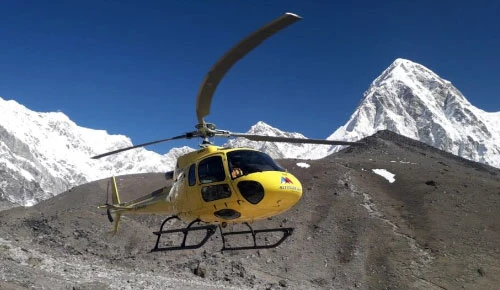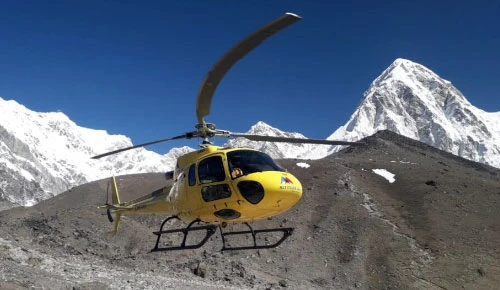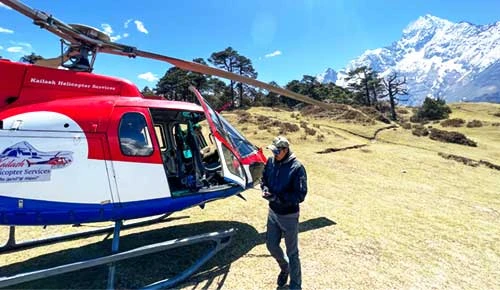Food and Accommodation While Trekking in Nepal
Trekking is a type of outdoor activity that involves walking or hiking over long distances, often in rugged or remote areas. Food and accommodation are two important factors that need to be considered when planning a trek.
Food is an essential component of any trek, as it provides energy and nutrients to keep hikers fueled and nourished during the journey. It is important to pack lightweight, non-perishable, and easy-to-carry food items such as energy bars, nuts, dried fruits, and trail mix. Some trekkers may also choose to carry a stove and cook their own meals, while others may rely on local vendors or campsites for food.
Accommodation is another important consideration when planning a trek. Trekkers can choose from various options, including camping, staying in lodges or guest houses, or renting a cottage or cabin. Some hikes may also offer the option of staying in a tent or yurt, or even in a tent village. It is essential to research the available accommodation options and choose one that meets your needs and budget.
Food and accommodation are important aspects of a trek, as they provide essential sustenance and shelter during the journey. It is important to research and plan carefully to ensure that these needs are met during the trek.
Generally speaking, the type of food and lodging available in Nepal's trekking regions varies according to the trekking location, proximity to transportation, and altitude variation. In Nepal, there are primarily two types of trekking: tent trekking and teahouse trekking. Teahouse trekking is a style of hiking in which you spend a lot of time at teahouses. These teahouses are well-stocked with the necessary items and offer room services. Camping trekking, as the name suggests, requires setting up camp along the way.
The most well-known trekking destinations, such as Everest, Annapurna, and Langtang, as well as Kathmandu, the main entry point to all of Nepal, are covered in this travel blog's information on food and hotel availability.
Table of Contents
Accommodation & Food in Kathmandu
Kathmandu, the capital city of Nepal, is known for its rich cultural heritage and diverse cuisine. It is also the starting point of the trek. As you will be landing in Kathmandu Airport and will stay here until the trek starts.
Food

There are many different types of food available in the city, including traditional Nepali dishes, Indian food, Tibetan food, and international cuisine. Here are a few popular options:
Traditional Nepali dishes: Dal Bhat is a staple food in Nepal, consisting of rice, lentil soup (dal), and a variety of side dishes. Other popular Nepali dishes include momos (dumplings), chow mein (noodles), and sekuwa (grilled meat).
Indian food: Kathmandu has a large Indian population, so you can find a wide variety of Indian restaurants in the city. Popular dishes include tandoori chicken, curry, and naan bread.
Tibetan food: Kathmandu is home to a large Tibetan community, so you can find many Tibetan restaurants in the city. Popular dishes include momos, thukpa (noodle soup), and shapta (stir-fried meat).
International cuisine: Kathmandu has a number of international restaurants that serve a variety of cuisines, including Italian, Mexican, and Thai.
Accommodation

There are a ton of lodging alternatives in Kathmandu, from $5 hostel rooms to $500 resorts, all of which are ideal for both budget and luxury travelers. Most homes are in convenient locations, especially in the Thamel area. The most popular neighborhood and tourist destination in Kathmandu are Thamel. Additionally, it is located in the center of the city, close to all of Kathmandu's top sights. This lively city has a variety of lodging options for you, no whatever your preferences or price range. There are many options for accommodation in Kathmandu, especially in the Thamel area. Some popular options include:
Hotel Tibet International: This 3-star hotel offers comfortable rooms with private bathrooms and amenities such as a restaurant, bar, and massage service.
The Thamel Eco Resort: This eco-friendly resort offers traditional Nepalese-style rooms and cottages with private bathrooms and a restaurant serving organic food.
The Thamel House: This budget-friendly guesthouse offers basic rooms with shared bathrooms and a rooftop terrace with views of the city.
The Kathmandu Eco Hotel: This eco-friendly hotel offers rooms with private bathrooms and amenities such as a restaurant, bar, and massage service.
The Thamel Hostel: This budget-friendly hostel offers shared dormitory rooms and private rooms with shared bathrooms, as well as a shared kitchen and common area.
Food and Accommodation in popular trekking areas
Most treks in Nepal are "teahouse" treks, even the well-known treks in well-known areas, allowing trekkers to travel light. You will just be sleeping in a small lodge with a few basic rooms and supper provided each evening if you choose a teahouse as your lodging option. In the majority of tea houses, private rooms are also available; nevertheless, at high altitudes, dormitories are the only choice. Most facilities are shared, and the hot shower can just be a bucket of lukewarm water. Toilets may be squat or western-style. A wooden cage with a bed, mattress, pillow, blanket, table, and curtain in place of a door might serve as a private space. Even these, seem like a luxury in comparison to spending the night in a tent on the trail in the bitter cold.
Regarding the meals, lunch will be provided while traveling to your next destination, and breakfast and dinner will be offered at the teahouse or from the menu of the lodge where you will be spending the night. As the elevation increases, the menu options become more limited, but it is still easier than carrying supplies for several days.
Let's explore in detail the types of accommodation and food trekkers on well-known trekking routes will experience.
Food and Accommodation in Everest Region
Hostels to luxury hotels are available on the Everest Region Trekking pathways to accommodate a variety of budgets. The Everest Base Camp Trail boasts the best accommodations and dining options because it is the most well-known trekking route in the country. They are less developed than the other high-altitude trekking destinations, yet they are still quite primitive.
Lukla: There are many top-notch hotels in Lukla, however, they are more expensive than the lodges. In addition to the always-welcomed hot showers, such hotels provide their visitors with lawns, balconies, and patio dining. Due to its location at the start of the EBC adventure, Since Lukla is the starting point for the trek, it receives the first shipments of imported goods and cuisines that are delivered to the Khumbu region for the Everest lodges. The meals are tasty, filling, and fairly priced. Almost anything is available here, including regional delicacies and Italian and Indian cuisine if you desire them.
Phakding: Phakding has enough restaurants and hotels on both sides of the river to accommodate everyone.
Namche Bazaar: It's not surprising that Namche, the biggest commercial town in the Everest Region, has a significant number of hotels—over 50, to be exact. The variety of prices is likewise from basic to expensive. In addition, Namche Bazar is renowned for its market, bakery, cafes, and restaurants. You will get any kind of national and international cuisine if you want. Take advantage of Namche's rather luxurious environment while you can because it might be your last opportunity to do so before continuing on.

Starting in Tengboche, prices start to rise, lodgings are simpler, and there are fewer meal options. In locations like Tengboche & Gorak Shep, you could often have to share a room with other trekkers or sleep in the dining room during peak season.
Food and Accommodation in Annapurna Region
The National Trust for Nature Conservation (NTNC) protects the Annapurna region, thus food and lodging options must follow strict guidelines, including defined prices, high standards of quality, sanitation, and the construction of tea houses along main routes. Depending on geography and altitude, different facilities offer different food and lodging.
Accommodation
Expect to stay in modest lodgings if you travel to Nepal to do trekking in the Annapurna region. After a long day of hiking, a tea house—which includes lodges and guesthouses—is a welcome sight with tea. The lodges are warm, comfortable, and well-appointed, but as you ascend higher, they get simpler. There are two twin beds in each room, and bathrooms are only available if you pay an extra fee while traveling, which is only offered by a select few lodges. You can borrow the mattresses, pillows, and blankets that are on the beds.

A private room, a hot shower, and a dining room with power outlets for charging gadgets and Wi-Fi are just a few of the amenities offered by lodging in the lower Annapurna regions. Your lodging options get increasingly basic as you go further into the Annapurna range. Basic lodging consists of a bunk-bed dorm-style room with a shared bathroom. Solar electricity is only provided for meals in the dining hall, so it's advised to carry a headlamp. It is important to reserve your accommodation in advance because as the main trekking season approaches, it gets quite crowded and tea houses with vacant rooms are harder to find.
Foods
An excellent fusion of western and Nepali food is served in the teahouses all along the Lower Annapurna Trekking Trails. Even though there are fewer meal alternatives in the higher Annapurna regions than there are in the lower regions, these meals still contain all the essential nutrients for a balanced diet. The breakfast options in the lower regions are excellent and range from the American set breakfast to the local set breakfast, while the only nutritious and filling options in the upper regions are potatoes, rice, Momos, and soup.
Food and Accommodation in Langtang Region
When compared to the Annapurna and Everest regions, the hotel and dining services in the Langtang region are still quite basic, but they are becoming better. The most popular treks in the Langtang region are the Tamang Heritage Trail, Hemlabu Trek, and Langtang Valley Trek, and they all provide similar dining and lodging options.
Accommodation
Due to the remoteness and limited transportation options, services are limited and accommodations amenities vary depending on elevation. Visitors will encounter a variety of tea houses with varied amenities when trekking in the Langtang region, many of which are managed by local families to support the local tourism industry. In the lower parts of the area, including Syabrubesi and Dhunche, the rooms are twin-sharing arrangements with connected bathrooms, hot showers, Wi-Fi, and power outlets for charging your equipment. The facilities may be observed decreasing as the elevation rises. Little mattresses, small rooms, and limited power are features of more modest housing. You could have to share a room with another traveler or sleep in the living room during the busiest seasons because there aren't many tea houses in the upper locations. After a long day of working your legs out, you would love to enjoy a good night's sleep, despite the minimal services.
Food
Many teahouses in the Langtang Region Treks serve a wide range of delicious, nutritious food, from spaghetti to Dal Bhat, a traditional Nepali dish. The teahouses along the trails provide breakfast, lunch, and dinner, with both vegetarian and non-vegetarian options available. There are numerous alternatives for alcoholic and non-alcoholic beverages in addition to the cuisine.
Every trekking route in the Langtang Region has a predetermined menu with a selection of snacks and drinks. Tea houses along the paths provide different breakfast, lunch, and dinner options. In the Lower Trekking regions, a variety of food options are available for meals, including meat, vegetables, salad, and fruits. Keep in mind that Syabrubesi and Dhunche are the only places to find meat and fruit. Planning is advisable for non-vegetarians because some areas of the region do not transport or sacrifice animals for religious reasons. Yak Cheese is the most intriguing thing to be discovered in the upper Langtang Region. The food there is a must-try.
Food and Accommodation in Manaslu Region
The Manaslu region of Nepal is a popular destination for trekkers and hikers. There are a number of small villages and tea houses along the trekking routes, which provide food and accommodation for travelers.
Accommodation
In the villages and tea houses, you can expect to find basic accommodation in the form of shared rooms or dormitories. The rooms may be basic, with simple furnishings and shared bathrooms. While some tea houses may offer different services like a single room, bathroom, hot water, and wifi, others just offer the most basic facilities.
Food
Food in the Manaslu region is typically Nepali, with a mix of rice, lentils, vegetables, and meat. You can also find western dishes such as pasta and pizza in some of the more tourist-oriented tea houses. Tea houses will often have a set menu with a range of dishes to choose from, or you can request a dish to be made to your specification. Prices for food in the Manaslu region can vary but you will get nutritious and filling food
It is also possible to camp in the Manaslu region, although you will need to bring your own camping equipment. There are a few designated camping areas along the trekking routes, and you can also ask permission to camp in some of the villages.
It is important to note that the Manaslu circuit trek is a remote and isolated area, and facilities are basic. It is recommended to be prepared for the challenges of trekking in a remote environment and to bring enough supplies to last the duration of your trip.
Drinking Water While Trekking in Nepal
You won't have to worry about finding drinkable water when hiking in Nepal because the most well-traveled trekking trails are filled with tea houses, taps, streams, and rivers. Bottled water is sold in teahouses in the lower regions, but it is twice as expensive there and becomes more expensive as you go in elevation. Furthermore, bottled water is detrimental to the environment because it uses a lot of plastic. Therefore, it is recommended to stay away from bottled water and just drink water that is available.
Drinking water directly from a natural resource is not advised. The most effective way to purify it is by boiling; however, there are other effective ways as well. The boiled water is offered by the teahouses for about $1 per cup.
After being purified, the water obtained from natural resources is free to consume.
We advise bringing your own refillable reusable water bottle. Getting one with a filter straw or carrying water purification pills would be better.
The quality of your journey to Nepal's Himalayas depends greatly on the food and accommodations you choose. Although these services are quite similar to many trekking routes, be ready to get the necessities and get a firsthand look at the villagers' way of life.
Our services
We provide all kinds of trekking, helicopter tours, day tours, multiday tours, expeditions, and other 200-plus activities in Nepal. If you are planning to travel to Nepal, let us know and we will make all kinds of arrangements to make your trip hassel-free. Write us with any kind of question regarding your trip to Nepal.




